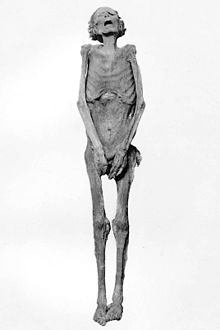| Pentawer | |
|---|---|
 Mummy of the "Unknown Man E", likely identified as Pentawer Mummy of the "Unknown Man E", likely identified as Pentawer | |
| Born | c. 1173 BCE Thebes |
| Died | 1155 BCE |
| Burial | Probably at DB320 |
| Father | Ramesses III |
| Mother | Tiye |
| Religion | Ancient Egyptian religion |
| |||||
| Pentawer in hieroglyphs | |||||
|---|---|---|---|---|---|
| Era: New Kingdom (1550–1069 BC) | |||||
Pentawer (also Pentawere and Pentaweret) was an ancient Egyptian prince of the 20th Dynasty, a son of Pharaoh Ramesses III and his secondary wife, Tiye. He was involved in the so-called "harem conspiracy", a plot to kill his father and place himself on the throne. The details of his trial are recorded in the Judicial Papyrus of Turin; he committed suicide following his trial. A candidate for his body is a mummy known as "Unknown Man E", discovered in the Deir el-Bahari cache in 1881. This mummy is unusual as it was found wrapped in a sheep or goat skin and was improperly mummified, being left with all his organs. Bob Brier has suggested that this mummy does indeed belong to the disgraced prince; DNA analysis has confirmed a father-son relationship with Pentawer's known father, Ramesses III, with both sharing the same Y chromosomal haplogroup and half of their DNA.
Conspiracy
The actual name of this prince is unknown, "Pentawer" being a pseudonym given to him on the Judicial Papyrus of Turin. He was to be the beneficiary of the harem conspiracy, probably initiated by his mother Tiye, to assassinate the pharaoh. Tiye wanted her son to succeed the pharaoh, even though the chosen heir was a son of the queen Tyti. According to the Judicial Papyrus, Pentawer was among those who were made to stand trial for their participation in the conspiracy. He was forced to kill himself:
Pentawere, to whom had been given that other name. He was brought in because he had been in collusion with Teye, his mother, when she had plotted the matters with the women of the harem concerning the making rebellion against his lord. He was placed before the butlers in order to be examined; they found him guilty; they left him where he was; he took his own life.
James Henry Breasted argued that Pentawer "was in all probability only an unfortunate tool" in the conspiracy. Susan Redford speculates that Pentawer, being a noble, was given the option to kill himself by taking poison and so be spared the humiliating fate of some of the other conspirators who were executed. If the means of execution was burning as Redford proposes - the related papyri themselves do not indicate the method of execution - this would have served to make a strong example since it emphasized the gravity of their treason for ancient Egyptians who believed that one could only attain an afterlife if one's body was mummified and preserved — rather than being destroyed by fire. In other words, not only were the criminals killed in the physical world, but they also did not attain an afterlife. By killing himself, Pentawer could avoid the harsher punishment of a second death. This could have permitted him to be mummified and move on to the afterlife. A recent study of the remains of "Unknown Man E" which are a candidate for his suggest that he died by strangulation or hanging. If the remains indeed are his, then he would have been about 18-20 years old at the time of his death.
Probable mummy
In recent times, the Egyptologist Bob Brier has revived the old hypothesis that the famed mummy of the "Unknown Man E" found in the Deir el-Bahari cache (DB320) might, indeed, be Pentawer. The mummy is very unusual because it appears to have been embalmed quickly, without removing the brain and viscera, and to have been placed in a cedar box, the interior of which had to be crudely hacked to widen it. Brier hypothesizes that Pentawer was mummified very rapidly and placed in an available coffin, likely by a relative, in order to give him a proper burial.
Subsequent DNA analysis supports the theory that the mummy was a son of Ramesses as they both share the paternal Y-DNA haplogroup E1b1a and half their DNA.
References
- Dodson, Aidan; Hilton, Dyan (2004). The Complete Royal Families of Ancient Egypt. London: Thames & Hudson. ISBN 0-500-05128-3., p.193
- ^ de Buck, A. (December 1937). "The Judicial Papyrus of Turin". The Journal of Egyptian Archaeology. 23 (2): 152–164. doi:10.2307/3854420. JSTOR 3854420.
- The Mystery of Unknown Man E, by Bob Brier, 2006, Archaeological Institute of America.
- ^ Hawass, Zahi; Ismail, Somaia; Selim, Ashraf; Saleem, Sahar N; Fathalla, Dina; Wasef, Sally; Gad, Ahmed Z; Saad, Rama; Fares, Suzan; Amer, Hany; Gostner, Paul; Gad, Yehia Z; Pusch, Carsten M; Zink, Albert R (2012). "Who killed Ramesses III?". BMJ: British Medical Journal. 345 (7888): 39–40. ISSN 0959-8138. JSTOR 23493394.
- ^ James Henry Breasted, Ancient Records of Egypt, Part Four, Chicago 1906, § 421
- Pascal Vernus, Affairs and Scandals in Ancient Egypt, Cornell University Press 2003, pp.108f.
- Collier, Mark; Dodson, Aidan; Hamernik, Gottfried (2010). "P. BM EA 10052, Anthony Harris, and Queen Tyti". The Journal of Egyptian Archaeology. 96: 242–247. doi:10.1177/030751331009600119. ISSN 0307-5133. JSTOR 23269772. S2CID 161861581.
- Redford, Susan (2002). The Harem Conspiracy. Northern Illinois Press. ISBN 9780875802954.
- The Mystery of Unknown Man E, by Bob Brier, 2006, Archaeological Institute of America.
- Brier, Bob, "Unknown Man E, A Preliminary Examination", Bulletin of the Egyptian Museum, Volume 3, Supreme Council of Antiquities, American University in Cairo Press, 2008, pp.23-7.